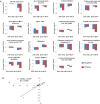Comparative Transcriptome Analysis of Bombyx mori (Lepidoptera) Larval Midgut Response to BmNPV in Susceptible and Near-Isogenic Resistant Strains
- PMID: 27168061
- PMCID: PMC4864234
- DOI: 10.1371/journal.pone.0155341
Comparative Transcriptome Analysis of Bombyx mori (Lepidoptera) Larval Midgut Response to BmNPV in Susceptible and Near-Isogenic Resistant Strains
Abstract
Bombyx mori nucleopolyhedrovirus (BmNPV) is one of the primary pathogens causing severe economic losses in sericulture. However, the molecular mechanism of silkworm resistance to BmNPV remains largely unknown. Here, the recurrent parent P50 (susceptible strain) and the near-isogenic line BC9 (resistance strain) were used in a comparative transcriptome study examining the response to infection with BmNPV. A total of 14,300 unigenes were obtained from two different resistant strains; of these, 869 differentially expressed genes (DEGs) were identified after comparing the four transcriptomes. Many DEGs associated with protein metabolism, cytoskeleton, and apoptosis may be involved in the host response to BmNPV infection. Moreover, some immunity related genes were also altered following BmNPV infection. Specifically, after removing genetic background and individual immune stress response genes, 22 genes were found to be potentially involved in repressing BmNPV infection. These genes were related to transport, virus replication, intracellular innate immune, and apoptosis. Our study provided an overview of the molecular mechanism of silkworm resistance to BmNPV infection and laid a foundation for controlling BmNPV in the future.
Conflict of interest statement
Figures







Similar articles
-
iTRAQ-based quantitative proteomics analysis of molecular mechanisms associated with Bombyx mori (Lepidoptera) larval midgut response to BmNPV in susceptible and near-isogenic strains.J Proteomics. 2017 Aug 8;165:35-50. doi: 10.1016/j.jprot.2017.06.007. Epub 2017 Jun 15. J Proteomics. 2017. PMID: 28624519
-
Comparative Subcellular Proteomics Analysis of Susceptible and Near-isogenic Resistant Bombyx mori (Lepidoptera) Larval Midgut Response to BmNPV infection.Sci Rep. 2017 Mar 31;7:45690. doi: 10.1038/srep45690. Sci Rep. 2017. PMID: 28361957 Free PMC article.
-
The digestive proteinase trypsin, alkaline A contributes to anti-BmNPV activity in silkworm (Bombyx mori).Dev Comp Immunol. 2021 Jun;119:104035. doi: 10.1016/j.dci.2021.104035. Epub 2021 Jan 31. Dev Comp Immunol. 2021. PMID: 33535067
-
The progress and future of enhancing antiviral capacity by transgenic technology in the silkworm Bombyx mori.Insect Biochem Mol Biol. 2014 May;48:1-7. doi: 10.1016/j.ibmb.2014.02.003. Epub 2014 Feb 20. Insect Biochem Mol Biol. 2014. PMID: 24561307 Review.
-
Discovery of anti-viral molecules and their vital functions in Bombyx mori.J Invertebr Pathol. 2018 May;154:12-18. doi: 10.1016/j.jip.2018.02.012. Epub 2018 Feb 14. J Invertebr Pathol. 2018. PMID: 29453967 Review.
Cited by
-
Transcriptomics and interactomics during the primary infection of an SfNPV baculovirus on Spodoptera frugiperda larvae.Front Cell Infect Microbiol. 2023 Nov 21;13:1291433. doi: 10.3389/fcimb.2023.1291433. eCollection 2023. Front Cell Infect Microbiol. 2023. PMID: 38076451 Free PMC article.
-
Quantitative label-free proteomic analysis reveals differentially expressed proteins in the digestive juice of resistant versus susceptible silkworm strains and their predicted impacts on BmNPV infection.J Proteomics. 2020 Jan 6;210:103527. doi: 10.1016/j.jprot.2019.103527. Epub 2019 Oct 11. J Proteomics. 2020. PMID: 31610263 Free PMC article.
-
CRISPR/Cas9-Mediated Disruption of the lef8 and lef9 to Inhibit Nucleopolyhedrovirus Replication in Silkworms.Viruses. 2022 May 24;14(6):1119. doi: 10.3390/v14061119. Viruses. 2022. PMID: 35746591 Free PMC article.
-
Comparative transcriptome analysis reveals significant metabolic alterations in eri-silkworm (Samia cynthia ricini) haemolymph in response to 1-deoxynojirimycin.PLoS One. 2018 Jan 11;13(1):e0191080. doi: 10.1371/journal.pone.0191080. eCollection 2018. PLoS One. 2018. PMID: 29324893 Free PMC article.
-
Bombyx mori C-Type Lectin (BmIML-2) Inhibits the Proliferation of B. mori Nucleopolyhedrovirus (BmNPV) through Involvement in Apoptosis.Int J Mol Sci. 2022 Jul 28;23(15):8369. doi: 10.3390/ijms23158369. Int J Mol Sci. 2022. PMID: 35955502 Free PMC article.
References
-
- Nagaraju J, Goldsmith MR. Silkworm genomics—progress and prospects. Curr Sci India. 2002; 83(4):415–25.
-
- Li MW, Shen L, Xu AY, Miao XX, Hou CX, Sun PJ, et al. Genetic diversity among silkworm (Bombyx mori L., Lep., Bombycidae) germplasms revealed by microsatellites. Genome. 2005; 48(5):802–10. - PubMed
MeSH terms
Substances
LinkOut - more resources
Full Text Sources
Other Literature Sources
Research Materials

